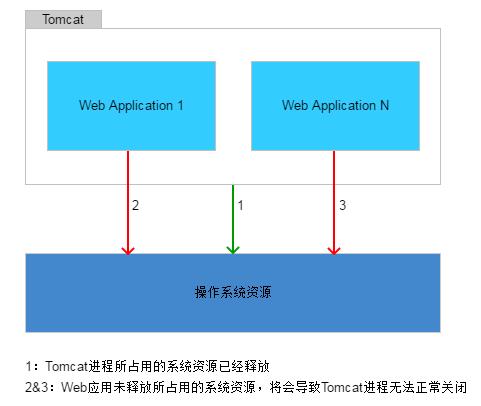
问题描述
通常,我们都会直接使用tomcat提供的脚本执行关闭操作,如下:
# sh bin/shutdown.sh
Using CATALINA_BASE: /usr/local/apache-tomcat-7.0.59
Using CATALINA_HOME: /usr/local/apache-tomcat-7.0.59
Using CATALINA_TMPDIR: /usr/local/apache-tomcat-7.0.59/temp
Using JRE_HOME: /usr/local/jdk1.8.0_121
Using CLASSPATH: /usr/local/apache-tomcat-7.0.59/bin/bootstrap.jar:/usr/local/apache-tomcat-7.0.59/bin/tomcat-juli.jar
但是执行该关闭操作之后,有时候会发现tomcat进程依然存在:
# ps uax |grep tomcat
root 1199 0.0 0.0 9120 468 ? Ss 21:53 0:00 /sbin/dhclient -H centosx64_tomcat1 -1 -q -lf /var/lib/dhclient/dhclient-eth2.leases -pf /var/run/dhclient-eth2.pid eth2
root 2081 9.7 60.7 2192828 295224 pts/0 Sl 22:04 1:04 /usr/local/jdk1.8.0_121/bin/java -Djava.util.logging.config.file=/usr/local/apache-tomcat-7.0.59/conf/logging.properties -Djava.util.logging.manager=org.apache.juli.ClassLoaderLogManager -Dmoc.debug=true -Djava.endorsed.dirs=/usr/local/apache-tomcat-7.0.59/endorsed -classpath /usr/local/apache-tomcat-7.0.59/bin/bootstrap.jar:/usr/local/apache-tomcat-7.0.59/bin/tomcat-juli.jar -Dcatalina.base=/usr/local/apache-tomcat-7.0.59 -Dcatalina.home=/usr/local/apache-tomcat-7.0.59 -Djava.io.tmpdir=/usr/local/apache-tomcat-7.0.59/temp org.apache.catalina.startup.Bootstrap start
root 2192 0.0 0.1 103332 848 pts/0 S+ 22:15 0:00 grep tomcat
这时我们就只能通过强制杀死进程的方式停止Tomcat了:kill -9 <tomcat_process_id>。
那么,为什么使用shutdown.sh无法正常停止Tomcat进程呢?
原因分析
停止Tomcat原理分析
我们先来看看tomcat实现关闭的原理是什么?如下为shutdown.sh脚本内容:
PRGDIR=`dirname "$PRG"`
EXECUTABLE=catalina.sh
# Check that target executable exists
if $os400; then
# -x will Only work on the os400 if the files are:
# 1. owned by the user
# 2. owned by the PRIMARY group of the user
# this will not work if the user belongs in secondary groups
eval
else
if [ ! -x "$PRGDIR"/"$EXECUTABLE" ]; then
echo "Cannot find $PRGDIR/$EXECUTABLE"
echo "The file is absent or does not have execute permission"
echo "This file is needed to run this program"
exit 1
fi
fi
exec "$PRGDIR"/"$EXECUTABLE" stop "$@"
显然,shutdown.sh只是一个执行入口,真正执行关闭操作是在catalina.sh中实现的,继续查看catalina.sh脚本内容,在其中关于调用stop方法的地方可以看到如下信息:
eval "\\"$_RUNJAVA\\"" $LOGGING_MANAGER $JAVA_OPTS \\
-Djava.endorsed.dirs="\\"$JAVA_ENDORSED_DIRS\\"" -classpath "\\"$CLASSPATH\\"" \\
-Dcatalina.base="\\"$CATALINA_BASE\\"" \\
-Dcatalina.home="\\"$CATALINA_HOME\\"" \\
-Djava.io.tmpdir="\\"$CATALINA_TMPDIR\\"" \\
org.apache.catalina.startup.Bootstrap "$@" stop
# stop failed. Shutdown port disabled? Try a normal kill.
if [ $? != 0 ]; then
if [ ! -z "$CATALINA_PID" ]; then
echo "The stop command failed. Attempting to signal the process to stop through OS signal."
kill -15 `cat "$CATALINA_PID"` >/dev/null 2>&1
fi
fi
首先需要调用Tomcat的Bootstrap类,然后再通过kill命名停止Tomcat进程。但是注意 到在这里使用kill命令发送的信号为SIGTERM(15),也就是说有可能不能停止Tomcat进程(如:进程未释放系统资源)。
下面先追踪一下Bootstrap类的实现:
if (command.equals("startd")) {
args[args.length - 1] = "start";
daemon.load(args);
daemon.start();
} else if (command.equals("stopd")) {
args[args.length - 1] = "stop";
daemon.stop();
} else if (command.equals("start")) {
daemon.setAwait(true);
daemon.load(args);
daemon.start();
} else if (command.equals("stop")) {
daemon.stopServer(args);
} else if (command.equals("configtest")) {
daemon.load(args);
if (null==daemon.getServer()) {
System.exit(1);
}
System.exit(0);
} else {
log.warn("Bootstrap: command \\"" + command + "\\" does not exist.");
}
在Bootstrap的main方法中会根据在catalina.sh脚本传递的不同参数(start,stop)执行不同的方法。其中,当参数为stop时会调用stopServer()方法。
/**
* Stop the standalone server.
* @param arguments Command line arguments
* @throws Exception Fatal stop error
*/
public void stopServer(String[] arguments)
throws Exception {
Object param[];
Class<?> paramTypes[];
if (arguments==null || arguments.length==0) {
paramTypes = null;
param = null;
} else {
paramTypes = new Class[1];
paramTypes[0] = arguments.getClass();
param = new Object[1];
param[0] = arguments;
}
Method method =
catalinaDaemon.getClass().getMethod("stopServer", paramTypes);
method.invoke(catalinaDaemon, param);
}
实际上,最终的停止服务操作是通过反射方式执行了Catalina类中的stopServer()方法,如下所示:
public void stopServer(String[] arguments) {
if (arguments != null) {
arguments(arguments);
}
Server s = getServer();
if (s == null) {
// Create and execute our Digester
Digester digester = createStopDigester();
File file = configFile();
try (FileInputStream fis = new FileInputStream(file)) {
InputSource is =
new InputSource(file.toURI().toURL().toString());
is.setByteStream(fis);
digester.push(this);
digester.parse(is);
} catch (Exception e) {
log.error("Catalina.stop: ", e);
System.exit(1);
}
} else {
// Server object already present. Must be running as a service
try {
s.stop();
} catch (LifecycleException e) {
log.error("Catalina.stop: ", e);
}
return;
}
// Stop the existing server
s = getServer();
if (s.getPort()>0) {
try (Socket socket = new Socket(s.getAddress(), s.getPort());
OutputStream stream = socket.getOutputStream()) {
String shutdown = s.getShutdown();
for (int i = 0; i < shutdown.length(); i++) {
stream.write(shutdown.charAt(i));
}
stream.flush();
} catch (ConnectException ce) {
log.error(sm.getString("catalina.stopServer.connectException",
s.getAddress(),
String.valueOf(s.getPort())));
log.error("Catalina.stop: ", ce);
System.exit(1);
} catch (IOException e) {
log.error("Catalina.stop: ", e);
System.exit(1);
}
} else {
log.error(sm.getString("catalina.stopServer"));
System.exit(1);
}
}
如上所示,Tomcat进程的关闭操作需要做2件事:
第一:调用Bootstrap类的方法释放Tomcat进程所占用的资源。
第二:使用kill命令停止Tomcat进程:kill -15 <tomcat_process_id>。
为什么停止Tomcat之后进程依然存在
Tomcat是一个Servlet容器,用于部署Serlvet程序(我们通常写的各种Java Web应用本质上就是一个Servlet程序)。也就说,在停止Tomcat时不仅仅需要释放Tomcat进程本身所占用的资源,还需要释放Serlvet程序所占用的资源。而出现“停止Tomcat之后进程依然存在”这种现象的主要原因就是:我们自己写的Java Web应用在Tomcat容器停止时没有正常释放所占用的系统资源,比如:线程池未关闭,输入输出流未关闭等等。我在实际开发中就曾遇到因Kafka客户端未关闭到导致Tomcat无法正常停止的情况。然而,这却是很多做Web应用开发的程序员未引起注意的地方。往往都是不能正常关闭就直接强制杀死进程,当然达到了目的,但这并不是一个很好的做法。

解决方案
我们必须确保在容器退出时正确地释放相应资源,如:实现ServletContextListener监听器接口,在contextDestroyed()方法中执行相应的关闭操作。
public class ResListener implements ServletContextListener {
public void contextInitialized(ServletContextEvent sce) {
//TODO:初始化资源
}
// 释放资源,否则容器无法正常关闭
public void contextDestroyed(ServletContextEvent sce) {
//TODO:释放资源
}
}
【参考】
[1]. http://han.guokai.blog.163.com/blog/static/1367182712010731149286/ Tomcat无法正常关闭